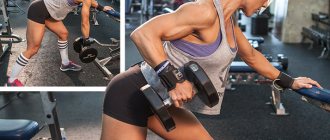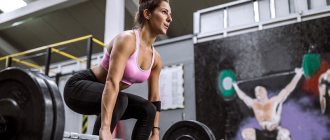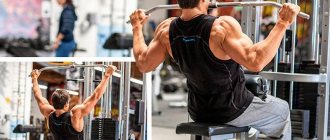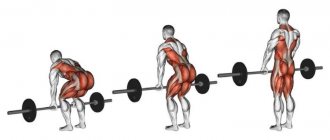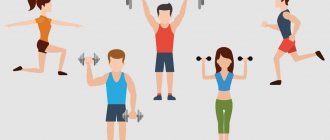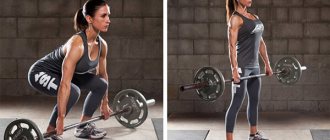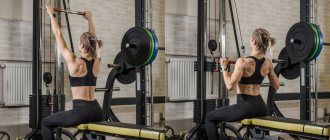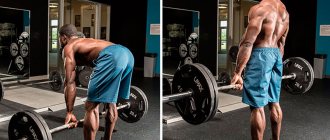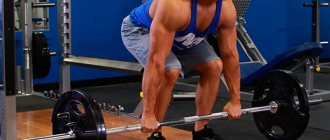Fortunately, there are plenty of exercises for developing the back to symmetrically develop muscles and select exercises depending on your physical fitness. There is always an alternative: for those who cannot do pull-ups with their own weight and are not yet ready to work with free weights, structures and exercise machines come to the rescue that improve positional stability and provide an understandable and comfortable technique for everyone. One of the effective methods of strengthening the back muscles is the T-bar row, which is performed in an inclined position, as well as in support on a special simulator.
Benefits and features of the T-bar row
- A multi-joint exercise allows you to effectively load the latissimus dorsi muscles and select the specific working weight needed by the athlete at this stage. This happens by adding barbell plates weighing from 2.5 to 25 kg.
- This design, with a foot platform and attached bar and handles, allows for a pulling motion similar to a barbell or dumbbell row. Unlike free weights, a T-bar requires less force to hold the equipment.
- The supported option is safer, since the position of the back is stabilized by a special design, reducing the likelihood of rounding the spine and, accordingly, getting injured.
- The T-bar row is not a simple exercise, but it significantly improves the stability of the weight and reduces the effort required to maintain the starting position.
- Using the T-bar in combination with other exercises, you can develop a powerful back.
Execution Features
To get the most benefit and efficiency from the T-bar row, check out the following guidelines:
- When lowering the weight at the lowest point of the amplitude, the arms do not fully extend, otherwise a traumatic load on the elbow joints occurs.
- The exercise should be performed with a bend in the lower back and a straight back. To prevent your back from rounding, you need to move your pelvis back and bend your knees slightly. This way you can ensure safety and comfort during the exercise.
- When rowing the bar, try to keep your elbows as close to your body as possible, this will make it easier to control the trajectory of the movement.
- Don't start your workout with too much weight. Many athletes get injured due to the fact that they choose prohibitive weights.
- Perform the row smoothly, avoid jerking movements, and move the bar evenly throughout the entire range of motion. To control the correct execution technique, you can position yourself in front of a mirror.
Moving the T-bar through space will be easier and the range of motion will be longer when using smaller diameter discs. Large discs can also make it difficult for you to hold the barbell. It is advisable to take several small disks instead of one large one.
What muscles work during the T-bar row?
As in any exercise, there are main - target muscles, as well as auxiliary ones , which are in static tension and aimed at maintaining body position, in this case these are the abdominal and lower back muscles.
Main muscles:
- Latissimus dorsi muscle.
- Teres minor muscle.
- Teres major muscle.
- Rhomboid muscle.
- Trapezius muscle - middle part.
- Infraspinatus muscle.
- Spinal straightener.
- Posterior bundle of the deltoid muscle.
- Biceps brachii.
- Brachial muscle.
- Brachioradialis muscle.
Exercise options
Before you start training, you need to decide on the load, depending on what part of your back you are going to train. In accordance with this, the following variants of the element are distinguished:
Bent-over bar row to chest
This version of the bent-over T-bar row is used when it is necessary to emphasize the load on the upper back. In this case, you just need to stand away from the part of the bar on which the weights are attached. At the same time, try to calculate as accurately as possible the distance at which you should stand, otherwise you risk receiving a careless blow to the head when you jerk the bar sharply.
Bent-over row of the bar to the belt
This type of exercise is used to pump the lower part of the latissimus dorsi muscles. Here you should take a position as close as possible to the edge of the simulator, i.e. to the end of the bar with attached weights.
The grip is also of great importance. The wider it is, the stronger the teres minor and major muscles will work. Parallel and close grips engage the latissimus dorsi muscles more. A reverse grip will allow you to work deeper on the lower part of the latissimus muscles, connecting the biceps to the work.
Bent-over T-bar row technique
Option 1
- Before taking the starting position, place weights of the required weight on the bar.
- Place your feet on a special platform.
- Bend your knees, keeping your back straight, grab the horizontal handles with both palms with an overhand grip and assume a stable 45-degree tilt position, maintaining tension in your abdominal and lower back muscles.
- As you exhale, without jerking, pull the T-bar toward your chest, bringing your elbows closer to your torso.
- As you inhale, gently lower the bar, straightening your arms at the elbows.
- Maintain the position of your spine, do not sway or round your back.
- At the end of the exercise, squat down and lower the bar down.
Option 2
You can also perform the reverse grip , that is, grab the handles from below. This will transfer most of the load to the biceps brachii. In the upper range of motion, the load will be concentrated in the upper part of the trapezius, and not in the middle.
Option 3
Most T-bar designs have parallel handles for a neutral grip , which is convenient for holding heavy loads and is comfortable for many due to the morphology. This grip also reduces the load on the brachioradialis muscles.
Neutral grip
Main technical points
- Throughout the entire exercise, be sure to keep your back straight (arched in the lower back), almost parallel to the floor, or if you are already working with weights (then just above parallel, so as not to ruin your lower back).
- Do not forget that your knees are slightly bent (they are not straight; with straight legs, your back will round, and this is unacceptable, because there will be injuries and less effective contraction of the back muscles).
- While performing the exercise, your gaze should be strictly forward (in front of you), if you look down, your back will immediately round and you can get injured (in the worst case), in the best case (you will be lucky, you will not get injured, but your back muscles will not receive the proper load, as they could get with the correct position of the back muscles).
- At the top point (when you pulled the weight to your stomach), squeeze your shoulder blades (required) so that your back muscles are activated.
- When you pull the bar (to the top point) i.e. to the lower abdomen, try, firstly, to pull the bar (barbell) along your legs to the lower abdomen and at the same time (secondly), try to keep your elbows closer to the body, i.e. do not spread them to the side, keep them closer to the body.
- When you already use decent weights, I recommend using STRAPS (in order to hold this same weight), the trick is that our cysts are much weaker than our backs or biceps, therefore, why not help them? Use it! See below (how to wrap the straps around the bar):
- Breathing as always (i.e. EXHALE WITH EFFORT). Those. pulled the weight to the stomach - EXHALE (through your mouth), lower down (to the lowest point) = inhale (take in air through your nose).
- At the top point of the movement, when you pull the weight to your stomach and squeeze your shoulder blades together, hold in this position for 1-2 seconds and make a peak contraction of your back muscles.
- THE HANDS AT THE BOTTOM POINT DO NOT STRAIGHTEN COMPLETELY!!! This is very important, i.e. your elbows should be slightly bent, your arms should not be stupidly straight (otherwise the load on the back muscles will go away, and the exercise will become less effective than it could be).
T-bar row technique with emphasis
This design involves special support for the abdomen. There are 2 pairs of handles: horizontal - provide a wide grip and develop the width of the back, parallel handles - provide a narrow, neutral grip to develop the thickness of the back muscles.
- Place your feet on the platform and rest your stomach on the support.
- Grab the required handles with straight hands and select the desired grip, as in the previous options.
- Exhale and pull the bar toward your chest.
- As you inhale, return down, straightening your elbows completely.
The advantage of this option is that it requires less effort to maintain the position, but the disadvantage is that when working with a large weight, the chest is compressed and breathing worsens.
Features of the exercise
The peculiarity of the exercise and the difference, for example, from a barbell deadlift is the fixation of one end of the bar. As a result, there is no need to control the trajectory of the bar and only the back muscles are involved in the work, excluding the work of the stabilizer muscles. There are several simulators for performing the element, allowing you to work from a lying or standing position. In the absence of the latter, you can connect a regular rod to the work.
The bent-over row of a barbell or barbell consists of the fact that one end of the barbell is attached to the floor and rests against something hard, and weights from the barbell are placed on the other side of the equipment. You will also need a V-shaped handle from a pulley machine for horizontal rows. The load when performing the element can be changed: you can focus on working both the upper back and the lower part of the latissimus muscles. To do this, the direction of the pull to the body changes: it can be a pull to the chest or to the belt.
What is better to do - T-bar row or bent over row?
You can’t choose one best exercise for your whole life, just like you can’t say which exercise is best. There is only a difference in the features and anatomy of the exercise. The main difference between a T-bar row and a barbell is that the T-bar design makes it easier to maintain body position than lifting free weights.
Barbell deadlifts involve instability, which forces more muscle fibers into the exercise, and for the same reasons, lifting free weights will always be more challenging than training with machines. The T-bar row is a good option in preparation for barbell work. Or it would be appropriate to combine a barbell row with a T-bar row in a wide grip position.
Read more about bent over rows →
Muscles working in exercise
Bent-over T-bar rows work several large muscle groups at the same time, which will allow you to well load and pump up the entire array of back muscles.
The key load when performing is aimed at the latissimus dorsi muscles.
In addition to them, the trapezius muscles, teres major, rhomboid muscles, back extensor muscles, as well as the rear deltoids and biceps take part in the deadlifts.
The T-bar row is great for developing the muscles between the shoulder blades. In addition, the abs, forearms and thigh muscles receive static load.
Proper execution
The exercise can be performed either using a special simulator or using an ordinary barbell, with discs (plates) removed from one end.
There are different types of T-lift simulators based on their design. Some of them are designed to perform the exercise in a lying position. The advantage of this option is that fewer stabilizer muscles are involved in the execution, including the legs. However, there is also a significant drawback - in a lying position, it is impossible to achieve the necessary deflection in the lumbar region, which contributes to maximum contraction of the back muscles.
In addition, there are exercise machines that have a special platform, upon standing on which the bar and handle are pulled. This option is quite effective, but you need to correctly take the starting position in it, depending on your height and joint flexibility.
There are exercise machines that have a chest support, as well as those without a chest support. They also differ depending on different grips. But the mechanics of movement are the same everywhere. First, let's look at the most basic version of the exercise - using a regular barbell. Once you master the technique of moving with a barbell, you will not have problems with any exercise machine.
Technique for performing T-bar rows
- Place the required weight in the form of weights on the free end of the barbell. Rest the other end of the bar against something or fix it in a corner or under another weight. Take the handle from the horizontal row machine and secure it to the bar next to the weights. If you don’t have a handle at your disposal, you can simply grab the bar with both hands closer to the plates (with one hand take it a little closer, and the other a little further, changing hands after each approach).
- Place the barbell between your legs, bend over, keeping your back straight and arched. Your legs are slightly bent at the knees so that you can keep your back arched in the lumbar region. Grasp the bar securely, the muscles of the legs and abs are tense. The gaze is directed forward. Raise your body so as to lift the bar off the floor. When performing the movement, you should focus on the work of the back muscles. The leg muscles should only bear static load.
- As you exhale, pull the barbell towards you, the main work should be done by the latissimus dorsi muscles. Follow the trajectory of your elbows, which should move close to your body. At the top point of the amplitude, you need to linger for 1-2 seconds, bringing your shoulder blades together and feel the contraction of your back muscles.
- As you inhale, slowly lower the barbell to the starting position, feeling the muscle stretch. At the same time, the elbows below should not bend completely, and the pancakes should not touch the floor.
Perform this movement for 3-4 sets of 10-12 repetitions.
The T-bar row is a heavy multi-joint exercise. On the day of your back workout, it should be done close to the start of your workout. We recommend alternating it with bent-over barbell rows.
When performing the T-bar row exercise, you can change the grip width using different handles. When a narrow grip is used, the amplitude of the movement increases, but this greatly involves the biceps in the work. If you use a wide grip, the arm muscles work less in movement, but the range of movement becomes shorter.
T-bar row
Working muscles
When performed correctly, almost the entire upper back receives significant load. The “wings”, the teres major muscle and the posterior deltoids have to work the most. They are loaded throughout the entire movement.
The rhomboid and trapezius muscles, as well as the biceps of the arms, are less involved.
To whom, when and why
This exercise is a multi-joint exercise - basic, so its inclusion in the program is relevant for all athletes. By the way, in terms of the technique of influencing muscle groups and the principle of movement, it differs little from the bent-over barbell row, having certain differences and advantages. For example, the T-barbell row may seem like a much simpler and more convenient option, due to the clearly limited trajectory of the bar movement.
To whom?
Athletes of all levels of training. Performing T-pulls is relevant and useful for both major professionals and beginners just starting their sports career. First of all, this option is suitable for those who find it inconvenient or too difficult (for beginners) to perform bent-over barbell rows.
When?
On the day of back training, after warming up. You can perform the exercise either after another basic exercise (for example, a deadlift), or at the very beginning of the workout.
You can do T-lifts both during the period of mass gain and during “drying” - naturally, with its own differences and features. However, when working on relief, it will be more effective to perform bent-over barbell rows - due to the fact that it uses more muscles (to keep the body in the correct position).
For what?
For high-quality work of the upper back, in particular the lats, which do not receive maximum load when pulling the upper block (pull-ups with a wide grip behind the head). Suitable both for increasing muscle mass and for giving clear outlines to muscles during the “drying” period. Bodybuilding involves setting goals from the very beginning. You should not mindlessly lift the barbell.
Deadlift technique
Previously, this exercise was performed without special benches and exercise machines - practically, athletes performed the same bent-over row, only with a special T-bar. Now in almost any gym there are benches with stops designed specifically for this exercise - this is the option we will consider.
- We lie down with our chests on the bench. The body is completely straight, the shoulder joints are located above the edge of the bench. Hands are freely lowered down.
- We grab the handles with both hands. The classic version is narrow handles (about 10-15 centimeters), installed parallel to each other. At the same time, the shoulders move forward, the arms are fully straightened. This is the original one.
- Inhale, hold your breath and start moving. Without moving your elbows away from your body, use your back muscles to pull the bar up. In this case, the movement is performed not only with your hands - at the same time pull the shoulder joint back. The peak point of movement is when the handles touch the bench.
- Hold for a short while, tensing your back muscles as much as possible. Exhale and smoothly lower the barbell to the stop.
- Repeat the required number of times.
Important nuances and tips
- Working weight. It is selected depending on the period of training: when gaining - average or maximum, when “drying”, naturally - minimum or average. The weight is selected, as in other exercises, so that you can independently and efficiently do at least 5 repetitions. It should be noted that with maximum weight the exercise becomes more difficult - “cheating” is involuntarily applied.
- Frame. During the entire exercise, the body must remain motionless - watch this and do not lean back during the pull.
- Elbows. When performing an exercise with narrow parallel handles, make sure that your elbows move as close to your body as possible. At the top point, the elbow joint should be further than the level of the back.
- At the top point, try to squeeze your shoulder blades together as much as possible - to increase the load on the muscles of the upper back.
- Make sure that the biceps are involved in the work as little as possible, especially at the bottom of the movement - this will remove some of the load from the back muscles.
- To increase the effectiveness of your training, you can “finish off” the muscles on the same bench, working with dumbbells along the same trajectory.
Now you know how to tone your back with T-bar rows.
Leg bending in the simulator
Working muscles: muscles of the back of the thigh, calf.
This classic hamstring isolation exercise is a great complement to the T-bar row. Together they will create a load on almost the same complex of muscles as in the deadlift. The T-bar row will hit your back muscles, and leg curls will help work the back of your thighs. Only the gluteal and trapezius muscles will remain out of work.
Technique
- Lie on your stomach on the machine, place your legs behind the rollers.
- Take a breath, hold your breath. Raise your legs and exhale during the most difficult part of the exercise.
- Pause briefly at the point of maximum contraction of the hamstrings and slowly inhale to return to the starting position.
Details
- Do not lift your pelvis where the bench bends.
- By changing the position of the feet, you can shift the emphasis - work either the outer part of the muscles of the back of the thigh, or the inner. Heels together - the outer side works more, toes together - the inner side.
- The higher the range of motion, the better. Don't shorten it.
- If you pull your toes toward you during the exercise, your calves will receive additional stress.
How to do it correctly?
First of all, you need to understand the variety of simulators for performing the exercise. With the help of one group, the exercise is performed lying down, which removes the extra burden of lying down. Although in this case, flexibility of the lower back does not develop. In another group on the simulator, the performer must stand with his feet on a special platform, and the main problem with this version of the exercise is finding a comfortable position to perform the exercise. Now you need to familiarize yourself with the T-bar rowing technique on a classic setup with a leg platform:
- 1) A certain number of weights are installed at the end of the barbell, but you can start without them to understand the mechanics of the exercise. The other end of the rod is fixed to the bracket, so it is motionless. The end of the bar on which the pancakes are placed is grasped with both hands by the special handles.
- 2) It is advisable to place the brushes parallel to each other. Now, bending at the waist, you need to keep your back straight, and placing the barbell between your legs, align your body to lift the weight off the floor. The movement should not be performed with the muscles of the arm, but rather with the muscles of the back. The knees are kept bent to maintain the arch in the lower back and the legs are used only for this purpose.
A set of exercises to replace deadlifts
An alternative to ST is selected depending on what goal the athlete is pursuing, as well as on the nature of the activity: in the gym you can perform exercises on machines or work with an upper block. At home, you can get by with working with dumbbells or, if you have one, a barbell.
Working on trapezoids
For maximum quality work on the trapezius muscles, you can replace the deadlift with three exercises. The main thing is to row the barbell with a straight grip in an inclined position. Additional exercises are shrugs, dumbbell rows to the stomach. Additional ones will increase the load on the trapezius, help increase the relief, but will not put stress on the knees, and will reduce the risk of lower back injuries.
Bent-over barbell row
- Feet are shoulder-width apart, legs slightly bent. While bent over, grab the projectile with a straight or overhand grip.
- Carefully straighten up while lifting the projectile. Don't bend your arms, watch your elbows.
- Bend a little, lean forward. Watch for tension in your lower back. Do not lift the bar above your knees.
- Pull the bar toward your upper abdomen, pushing your elbows back. Raise your elbows as high as possible.
- Try not to use your biceps, tense your back muscles. Move smoothly - jerking leads to injury.
Shrugs
This exercise is performed with dumbbells - an easier option for beginners, or a barbell - when the athlete has mastered the technique. It can be done standing, lying on a horizontal or inclined bench.
- Hold the projectile down, arms straight.
- Raise your shoulders higher. The back and elbows are straight, no bends. Tighten your back muscles and abs.
- Fix at the top point, pause there for one or two seconds. Drop your shoulders.
Work with light weight so that you can perform at least ten repetitions.
Dumbbell rows to the stomach
This exercise can be performed in the gym or during home workouts. Trainers advise starting a complex with it to work the back muscles, trapezius and even the latissimus. Do it slowly, without sudden movements or jerks, so as not to injure muscles or ligaments.
- Take the apparatus, bend your knees and bend over.
- Lower the exercise equipment and begin deadlifting. The main emphasis is on the shoulder blades, the direction of the dumbbells is towards the upper part of the abs. Try to strain your elbows as little as possible; it is better if they do not bend. Watch your spine - there should be no bends.
- In the extreme position, stop and hold for a couple of seconds.
- Slowly lower your arms.
To increase the load, change the direction of movement of the projectile - the higher you lift it, the more actively the trapezoids will work.
Working on the lats
A good replacement for deadlifts to target these muscles is weighted pull-ups. You can do bent rows using an underhand or reverse grip. Additionally, they do the following rows: inclined with one arm, to the chest - this kind of row is done on the “upper block” simulator.
Reverse grip barbell row
Perform it according to the same rules as the overhand row. The distance between your palms on the bar should be slightly greater than shoulder width.
- Place your feet at shoulder level and squat down a little. Take the bar of the projectile with a reverse grip: your palms pass under the bar, the ends of your fingers close at the top of the bar.
- Stand up straight, lifting the projectile, your elbows should not bend. Bend over slightly, keeping the bar level with your knees. Tighten your lumbar and back muscles.
- Pull the barbell towards you, moving your elbows back. They should move backwards and upwards.
Start with a light weight and increase it as you master the technique.
One-arm dumbbell row
This is a classic isolation exercise that allows you to fully load the latissimus muscles, especially their lower part. For the lower lats, this is one of the most effective exercises.
- Lower your leg bent at the knee onto a horizontal bench. With your hand of the same name, rest against the bench. Try to keep your body at an angle to the horizontal - this will increase the efficiency of the pull and relieve the biceps. Arch your lower back slightly.
- Take the sports equipment in your free hand with an overhand grip. Bending your arm at the elbow, move the projectile towards the pelvis. Don't use your biceps.
- When lowering your arm at the end of the exercise, move your shoulder forward a little and straighten your elbow - this will increase the load on the lat.
Pulldown to the chest on the upper block
This exercise is done on a simulator. Formally, it can be classified as a basic exercise, but it is better to perform it immediately after the main basic exercises for the back.
- Sit on the machine, grab the handle with a straight grip. The legs must be firmly positioned under the support bolsters.
- Bend your lower back slightly and begin rowing, pulling the handle toward your upper chest. The effort must be focused and clear.
- When the handle reaches the bottom point, fix your body in this position, and then immediately return to the IP.
Try to move your elbows back as much as possible, but do not tilt your back.
